金融英语句子翻译
- 格式:doc
- 大小:47.50 KB
- 文档页数:7
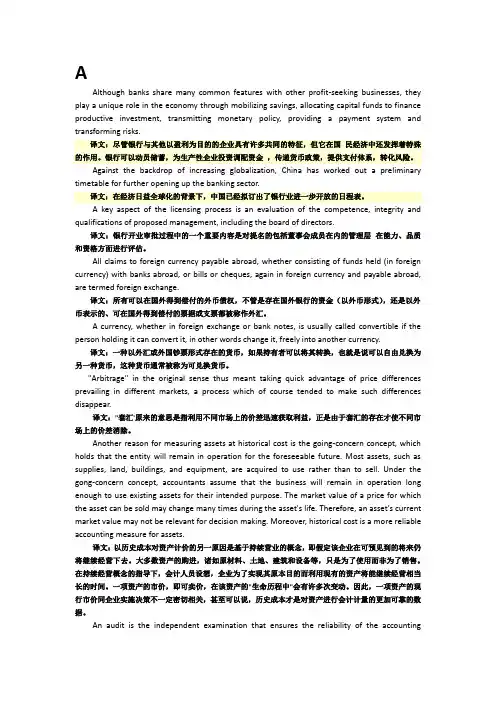
AAlthough banks share many common features with other profit-seeking businesses, they play a unique role in the economy through mobilizing savings, allocating capital funds to finance productive investment, transmitting monetary policy, providing a payment system and transforming risks.译文:尽管银行与其他以盈利为目的的企业具有许多共同的特征,但它在国民经济中还发挥着特殊的作用。
银行可以动员储蓄,为生产性企业投资调配资金,传递货币政策,提供支付体系,转化风险。
Against the backdrop of increasing globalization, China has worked out a preliminary timetable for further opening up the banking sector.译文:在经济日益全球化的背景下,中国已经拟订出了银行业进一步开放的日程表。
A key aspect of the licensing process is an evaluation of the competence, integrity and qualifications of proposed management, including the board of directors.译文:银行开业审批过程中的一个重要内容是对提名的包括董事会成员在内的管理层在能力、品质和资格方面进行评估。
All claims to foreign currency payable abroad, whether consisting of funds held (in foreign currency) with banks abroad, or bills or cheques, again in foreign currency and payable abroad, are termed foreign exchange.译文:所有可以在国外得到偿付的外币债权,不管是存在国外银行的资金(以外币形式),还是以外币表示的、可在国外得到偿付的票据或支票都被称作外汇。
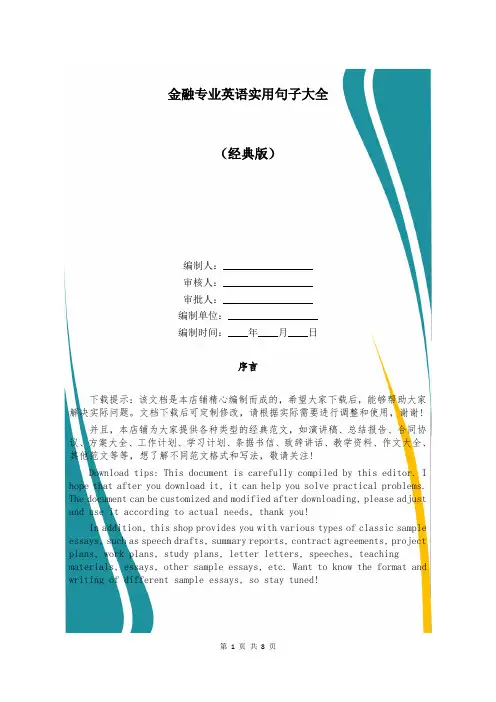
金融专业英语实用句子大全(经典版)编制人:__________________审核人:__________________审批人:__________________编制单位:__________________编制时间:____年____月____日序言下载提示:该文档是本店铺精心编制而成的,希望大家下载后,能够帮助大家解决实际问题。
文档下载后可定制修改,请根据实际需要进行调整和使用,谢谢!并且,本店铺为大家提供各种类型的经典范文,如演讲稿、总结报告、合同协议、方案大全、工作计划、学习计划、条据书信、致辞讲话、教学资料、作文大全、其他范文等等,想了解不同范文格式和写法,敬请关注!Download tips: This document is carefully compiled by this editor. I hope that after you download it, it can help you solve practical problems. The document can be customized and modified after downloading, please adjust and use it according to actual needs, thank you!In addition, this shop provides you with various types of classic sample essays, such as speech drafts, summary reports, contract agreements, project plans, work plans, study plans, letter letters, speeches, teaching materials, essays, other sample essays, etc. Want to know the format and writing of different sample essays, so stay tuned!金融专业英语实用句子大全为了帮助大家学好金融英语,提高金融水平,下面本店铺给大家带来金融专业英语实用句子大全,希望对大家有所帮助!金融专业英语实用句子11.The money which a bank obtains from its customers is generally known as its “deposits” and represents the balances which customers keep on their accounts with their banks. These accounts are of two main kinds: current accounts on which customers can draw check but receive no interest, and deposit and savings accounts on which the banks pay interest for the use of the money.1.银行从其客户那里得到的钱,一般被称为“存款”,代表客户在银行账户上持有的余额。
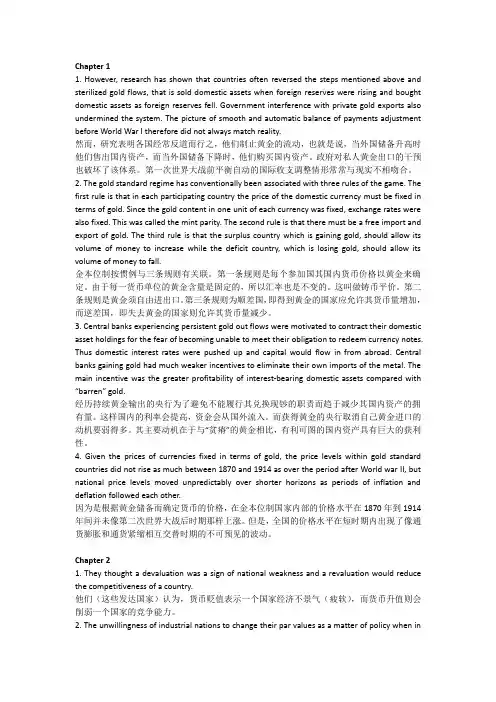
Chapter 11. However, research has shown that countries often reversed the steps mentioned above and sterilized gold flows, that is sold domestic assets when foreign reserves were rising and bought domestic assets as foreign reserves fell. Government interference with private gold exports also undermined the system. The picture of smooth and automatic balance of payments adjustment before World War I therefore did not always match reality.然而,研究表明各国经常反道而行之,他们制止黄金的流动,也就是说,当外国储备升高时他们售出国内资产,而当外国储备下降时,他们购买国内资产。
政府对私人黄金出口的干预也破坏了该体系。
第一次世界大战前平衡自动的国际收支调整情形常常与现实不相吻合。
2. The gold standard regime has conventionally been associated with three rules of the game. The first rule is that in each participating country the price of the domestic currency must be fixed in terms of gold. Since the gold content in one unit of each currency was fixed, exchange rates were also fixed. This was called the mint parity. The second rule is that there must be a free import and export of gold. The third rule is that the surplus country which is gaining gold, should allow its volume of money to increase while the deficit country, which is losing gold, should allow its volume of money to fall.金本位制按惯例与三条规则有关联。
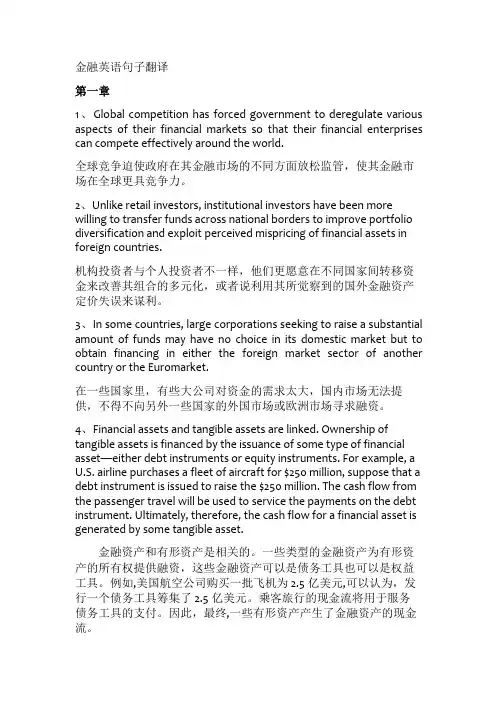
金融英语句子翻译第一章1、Global competition has forced government to deregulate various aspects of their financial markets so that their financial enterprises can compete effectively around the world.全球竞争迫使政府在其金融市场的不同方面放松监管,使其金融市场在全球更具竞争力。
2、Unlike retail investors,institutional investors have been more willing to transfer funds across national borders to improve portfolio diversification and exploit perceived mispricing of financial assets in foreign countries.机构投资者与个人投资者不一样,他们更愿意在不同国家间转移资金来改善其组合的多元化,或者说利用其所觉察到的国外金融资产定价失误来谋利。
3、In some countries,large corporations seeking to raise a substantial amount of funds may have no choice in its domestic market but to obtain financing in either the foreign market sector of another country or the Euromarket.在一些国家里,有些大公司对资金的需求太大,国内市场无法提供,不得不向另外一些国家的外国市场或欧洲市场寻求融资。
4、Financial assets and tangible assets are linked.Ownership of tangible assets is financed by the issuance of some type of financial asset—either debt instruments or equity instruments.For example,a U.S.airline purchases a fleet of aircraft for$250million,suppose that a debt instrument is issued to raise the$250million.The cash flow from the passenger travel will be used to service the payments on the debt instrument.Ultimately,therefore,the cash flow for a financial asset is generated by some tangible asset.金融资产和有形资产是相关的。



金融用英语怎么说finance和banking都是金融的英语。
1、finance。
读音:英[ˈfaɪnæns];美[fəˈnæns, faɪ-, ˈfaɪˌnæns]。
词性:n.和vt.。
做名词时意为金融,作动词时意为为…供给资金,从事金融活动;赊货给…;掌握财政。
变形:过去式:financed;过去分词:financed;现在分词:financing;第三人称单数:finances。
例句:The finance minister will continue to mastermind Poland's eco nomic reform.翻译:财政部长将继续策划波兰的经济改革。
2、banking。
读音:英[ˈbæŋkɪŋ];美[ˈbæŋkɪŋ]。
词性:n.和v.。
做名词时意为金融,做动词时意为堆积(bank的现在分词);筑(堤);将(钱)存入银行;(转弯时)倾斜飞行。
例句:His government began to unravel because of a banking scand al.翻译:他的政府由于一起金融丑闻而开始瓦解。
扩展资料金融的常见英文词组:financial ratios、financial stringency、financial ref orm。
1、financial ratios。
释义:财务比率。
中文解释:财务比率是财务报表上两个数据之间的比率,这些比率涉及企业管理的各个方面。
例句:Ratio analysis is the process of determining and evaluating fin ancial ratios.翻译:比率分析是指对财务比率进行决定和评价的过程。
2、financial stringency。
发音:[faɪˈnænʃ(ə)l ˈstrindʒənsi]。
释义:金融呆滞。
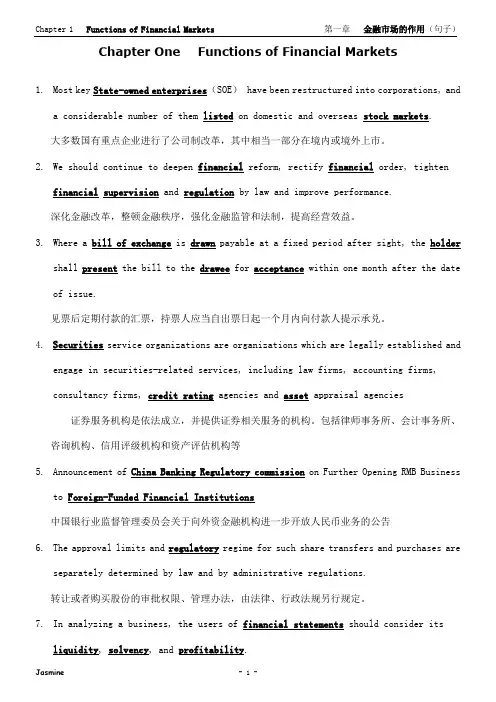
Chapter One Functions of Financial Markets1.Most key State-owned enterprises(SOE) have been restructured into corporations, anda considerable number of them listed on domestic and overseas stock markets.大多数国有重点企业进行了公司制改革,其中相当一部分在境内或境外上市。
2.We should continue to deepen financial reform, rectify financial order, tightenfinancial supervision and regulation by law and improve performance.深化金融改革,整顿金融秩序,强化金融监管和法制,提高经营效益。
3.Where a bill of exchange is drawn payable at a fixed period after sight, the holdershall present the bill to the drawee for acceptance within one month after the date of issue.见票后定期付款的汇票,持票人应当自出票日起一个月内向付款人提示承兑。
4.Securities service organizations are organizations which are legally established andengage in securities-related services, including law firms, accounting firms, consultancy firms, credit rating agencies and asset appraisal agencies 证券服务机构是依法成立,并提供证券相关服务的机构。

金融经典句子英文1. "The stock market is filled with individuals who know the price of everything, but the value of nothing." - Phillip Fisher2. "The investor's chief problem - and even his worst enemy - is likely to be himself." - Benjamin Graham3. "Money is only something you need in case you do not die tomorrow." - Carl Fox4. "The secret to wealth is simple: Find a way to do more for others than anyone else does." - Tony Robbins5. "The stock market is a device for transferring money from the impatient to the patient." - Warren Buffett6. "The best investment you can make is in yourself." - Warren Buffett7. "Opportunities come infrequently. When it rains gold, put out the bucket, not the thimble." - Warren Buffett8. "Investing should be more like watching paint dry or watching grass grow. If you want excitement, take 800 and go to Las Vegas." - Paul Samuelson9. "The four most dangerous words in investing are: 'This time it's different.'" - Sir John Templeton10. "The only way to permanently change the temperature in the room is to reset the thermostat. In the same way, the only way to change your level of financial success 'permanently' is to reset your financialthermostat." - T. Harv Eker11. "Don't gamble; take all your savings and buy some good stock and hold it till it goes up. If it don't go up, don't buy it." - Will Rogers12. "The markets can remain irrational longer than you can remain solvent." - John Maynard Keynes13. "Risk comes from not knowing what you're doing." - Warren Buffett14. "It's not how much money you make, but how much money you keep, how hard it works for you, and how many generations you keep it for." - Robert Kiyosaki15. "Behind every stock is a company. Find out what it's doing." - Peter Lynch16. "An investment in knowledge pays the best interest." - Benjamin Franklin17. "Wealth consists not in having great possessions, but in having few wants." - Epictetus18. "Investing should be more like watching paint dry or watching grass grow. If you want excitement, take 800 and go to Las Vegas." - Paul Samuelson.。
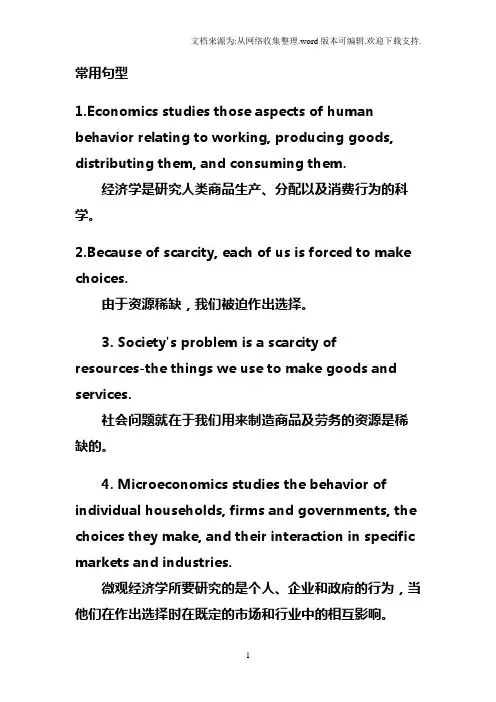
常用句型1.Economics studies those aspects of human behavior relating to working, producing goods, distributing them, and consuming them.经济学是研究人类商品生产、分配以及消费行为的科学。
2.Because of scarcity, each of us is forced to make choices.由于资源稀缺,我们被迫作出选择。
3. Society's problem is a scarcity of resources-the things we use to make goods and services.社会问题就在于我们用来制造商品及劳务的资源是稀缺的。
4. Microeconomics studies the behavior of individual households, firms and governments, the choices they make, and their interaction in specific markets and industries.微观经济学所要研究的是个人、企业和政府的行为,当他们在作出选择时在既定的市场和行业中的相互影响。
5. Total production of every good or service will be greatest when individuals specialize according to their comparative advantage.根据比较优势原则,当每个人专职从事某种商品生产或服务时,总产出将会最大。
Professional Englishinflationary spiral 螺旋式上升的通货膨胀neutrality of the centralbank中央银行的中立性counter-inflation policy 反通货膨胀对策open market policy 公开市场政策deficit-covering finance 赤字财政fiscal and monetarypolicy财政金融政策harmony of fiscal and monetary policies 财政政策和金融政策的协调interest rate policy 利率政策monetary device 金融调节手段monetary action 金融措施measures for monetaryease金融缓和措施easy credit 放松信贷monetary and credit货币信用管理controldeficit covering 弥补赤字restrictive lending policy 贷款紧缩政策over-loan position 贷款超额credit expansion 信用扩张credit control instrument 信用调节手段credit control 信用控制restrictive monetary紧缩通货膨胀policycredit extending policy 融资方针ultra-cheap money policy 超低息政策financial transaction 金融业务monetary market 金融市场financial unrest 金融动荡financial crisis 金融危机financial system 金融体系financial world 金融界policy of discount窗口指导政策windowopen market operation 公开市场业务1. 素质教育:Quality Education2. EQ:分两种,一种为教育商数Educational quotient,另一种情感商数Emotional quotient3. 保险业:the insurance industry4. 保证重点指出:ensure funding for priority areas5. 补发拖欠的养老金:clear up pension payments in arrears6. 不良贷款:non-performing loan7. 层层转包和违法分包:mutlti-level contracting and illegal subcontracting8. 城乡信用社:credit cooperative in both urban and rural areas9. 城镇居民最低生活保障:a minimum standard of living for city residents10. 城镇职工医疗保障制度:the system of medical insurance for urban workers11. 出口信贷:export credit12. 贷款质量:loan quality13. 贷款质量五级分类办法:the five-categoryassets classification for bank loans14. 防范和化解金融风险:take precautions against and reduce financial risks15. 防洪工程:flood-prevention project16. 非法外汇交易:illegal foreign exchange transaction17. 非贸易收汇:foreign exchange earnings through nontrade channels18. 非银行金融机构:non-bank financial institutions19. 费改税:transform administrative fees into taxes20. 跟踪审计:foolow-up auditing21. 工程监理制度:the monitoring system for projects22. 国有资产安全:the safety of state-owned assets23. 过度开垦:excess reclamation24. 合同管理制度:the contract system for governing projects25. 积极的财政政策:pro-active fiscal policy26. 基本生活费:basic allowance27. 解除劳动关系:sever labor relation28. 金融监管责任制:the responsibility system for financial supervision29. 经济安全:economic security30. 靠扩大财政赤字搞建设:to increase the deficit to spend more on development31. 扩大国内需求:the expansion of domestic demand32. 拉动经济增长:fuel economic growth33. 粮食仓库:grain depot34. 粮食收购企业:grain collection and storage enterprise35. 粮食收购资金实行封闭运行:closed operation of grain purchase funds36. 粮食销售市场:grain sales market37. 劣质工程:shoddy engineering38. 乱收费、乱摊派、乱罚款:arbitrary charges, fund-raising, quotas and fines39. 骗汇、逃汇、套汇:obtain foreign currency under false pretenses, not turn over foreign owed to the government and illegal arbitrage40. 融资渠道:financing channels41. 商业信贷原则:the principles for commercial credit42. 社会保险机构:social security institution43. 失业保险金:unemployment insurance benefits44. 偷税、骗税、逃税、抗税:tax evasion, tax fraud and refusal to pay taxes45. 外汇收支:foreign exchange revenue and spending46. 安居工程:housing project for low-income urban residents47. 信息化:information-based; informationization48. 智力密集型:concentration of brain power; knowledge-intensive49. 外资企业:overseas-funded enterprises50. 下岗职工:laid-off workers51. 分流:reposition of redundant personnel52. 素质教育:education for all-round development53. 豆腐渣工程:jerry-built projects54. 社会治安情况:law-and-order situation55. 民族国家:nation state56. “台独”:"independence of Taiwan"57. 台湾当局:Taiwan authorities58. 台湾同胞:Taiwan compatriots59. 台湾是中国领土不可分割的一部分:Taiwan is an inalienable part of the Chinese territory.60. 西部大开发:Development of the West Regions61. 可持续性发展:sustainable development62. 风险投资:risk investment63. 通货紧缩:deflation64. 扩大内需:to expand domestic demand65. 计算机辅助教学:computer-assisted instruction (CAI )66. 网络空间:cyberspace67. 虚拟现实:virtual reality68. 网民:netizen (net citizen )69. 电脑犯罪:computer crime70. 电子商务:the e-business71. 网上购物:shopping online72. 应试教育:exam-oriented education73. 学生减负:to reduce study load74. “厄尔尼诺”:(EL Nino)75. “拉尼娜”:(La Nina)76. “智商”:(IQ)77. “情商”:(EQ)78. “第三产业”:(third/tertiary industry,service sector,third sequence of enterprises)79.“第四产业”:(quaternary/information industry)80.“军嫂”:(military spouse)81.“峰会”(香港译“极峰会议”)“:summit (conference)82.“克隆”:clone83.“冰毒”:ice84.“摇头丸”:dancing outreach85.“传销”:multi level marketing86.“(计算机)2000年问题”:Y2K problem(y for year, k for kilo or thousand)87.“白皮书”:white paper(不是white cover book)88.“傻瓜相机”:Instamatic(商标名,焦距、镜头均固定,被称为foolproof相机);89.“白条”:IOU note(IOU:债款、债务,由I owe you 的读音缩略转义而来)90.“巡回招聘”:milk round(一种招聘毕业生的方式,大公司走访各大学及学院,向求职者介绍本公司情况并与报名者晤谈)。

Chapter 11. However, research has shown that countries often reversed the steps mentioned above and sterilized gold flows, that is sold domestic assets when foreign reserves were rising and bought domestic assets as foreign reserves fell. Government interference with private gold exports also undermined the system. The picture of smooth and automatic balance of payments adjustment before World War I therefore did not always match reality.然而,研究表明各国经常反道而行之,他们制止黄金的流动,也就是说,当外国储备升高时他们售出国内资产,而当外国储备下降时,他们购买国内资产。
政府对私人黄金出口的干预也破坏了该体系。
第一次世界大战前平衡自动的国际收支调整情形常常与现实不相吻合。
2. The gold standard regime has conventionally been associated with three rules of the game. The first rule is that in each participating country the price of the domestic currency must be fixed in terms of gold. Since the gold content in one unit of each currency was fixed, exchange rates were also fixed. This was called the mint parity. The second rule is that there must be a free import and export of gold. The third rule is that the surplus country which is gaining gold, should allow its volume of money to increase while the deficit country, which is losing gold, should allow its volume of money to fall.金本位制按惯例与三条规则有关联。
金融英语常用句子篇一:Unfortunately your price appears to be higher than ever.很遗憾,您的价格比以往都高。
Yes, we know. Because of the price hike in raw materials,we were forced to adjust our prices accordingly.是的,我们知道。
但由于原材料涨价,我们不得不相应调整产品的价格。
hike :(infml 口) rise in prices, costs, etc (价格、价值等的)提高,增加:* The union demands a 7% wage hike. 工会要求提高工资7%.Then what's your idea of a good price?那你觉得什么价格合适?I would say 20% off the listed price.标价减20%.Impossible. We won't make any profit at that price. 10% is the best we can do.那不可能。
这样我们就无钱可赚了。
最多降10%.It's still too high.还是太高。
Our quality is far beyond comparison. Besides, the market is advancing. Our goods can always find a good sale.我们的质量是无与伦比的。
而且行情上涨,我们的货物销路一直很好。
We are surprised to find that your price is 25% higher compared with other companies.发现你们的价格比其他公司的高25%,我们很吃惊。
25%? You can't be serious!25%?你不是开玩笑吧!That has been confirmed by our survey. I'm afraid I’ll have to cancel the deal unless you reduce your price.我们调查证实过了。
常用的金融英语口语对话带翻译提高英语口语能力,是学习金融英语的一个重点环节,下面店铺为大家带来常用的金融英语口语对话,欢迎大家学习!常用金融英语口语对话篇一T:We are happy to have Mr. David Long here with us today.教:今天我们很高兴地请到了英国某商业银行的大卫.朗先生。
Mr. Long is from a merchant bank in Britain. He will be talking about the organization of hisbank.朗先生给大家介绍一下他所在银行的组织体系。
L:I feel honoured to be talking with you today. I'd like to begin with your questions.朗:我今天非常荣幸地与大家在一起聚谈聚谈。
我希望同学们现在就提问。
S:Where is your bank located?学:请问贵银行位于什么地方?L:In London, the capital of Britain.朗:伦敦,英国的首都。
S:Could you give us a brief overview of your bank's history?学:您能给我们讲讲贵银行的历史概况吗?L:Yes, of course. We were established as long ago as 1869.朗:当然行啦!我们的银行早在1869年就有了。
Now, it is being operated as one of the major merchant banks in the City.现在它是伦敦几家最重要的商业银行之一了。
S:How is your bank organized?学:请问贵行是如何组成的呢?L:Well, that is really a big question.朗:啊,这可是一个很大的问题呀!S:Let me put it in this way. How many divisions are there inyour bank?学:我就这么问吧。
表达金融专业的英语句子英语的学习方法其实很简单的,大家要给点心思去学习哦,下面小编就给大家整理了金融英语句子,需要的可以收藏起来哦一1.You can usually borrow from the bank if he needs money. You can arrange for a bank loan at the loan department. If the bank lends you money, you must pay interest for its use. Sometimes, instead of putting his money in a savings account, you want to invest it in some business firm, and also may ask the investment department of his bank for advice.1.你如果需要钱用,通常可以向银行借。
你可以在银行贷款部筹到一笔银行贷款。
如果银行贷款给你,你就必须为使用这笔贷款而支付利息。
有时,你不把钱存放在储蓄账户上,而是想把钱投到实业中去,也可以向银行的投资部门咨询。
2.Investment banking includes securities underwriting, stock and bond trading and merger advice.2.投资银行业务包括证券承销、股票和债券交易以及提供并购建议。
3.General Motors in financial hardship is negotiating with the creditors in order to restructure debt.3.财务陷入困境的通用汽车目前正和债权人协商,以便重整债务。
4.A modern bank accepts people's money for safe-keeping. It also lends money and offers many other services. The experience of a businessman will show some of these.4.现代银行从客户手中吸收货币并加以妥善保管,也贷放货币,并提供许多其它服务。
ODI :ODI is investment of domestic assets into foreign countries, is not investment in the stock markets or in the equity of firms, is composed of M&A and investment.向外直接投资:向外直接投资是国内固定资产投资到国外,是不是在股票市场或在公司的股权,为M&A和投资组成的投资。
T/T: cable transfer or wire transfer——is the equivalent of a cash payment that can be credited directly to the seller‟s account.(telegraphic transfer)电汇:电汇或银行转帐- 是现金支付,可以直接存入卖家的帐户相同。
B/L: waybill or consignment note, and receipt (in postal or courier delivery) are collectively known as the transport documents.提单(bill of lading):提单或运单,及收据(在邮局或快递公司送达)被统称为运输单证。
L/C: It is the buyer who initiates the making of payment, by instructing his bank to issue a documentary credit in favor of the seller.信用证(Letter of Credit):我是谁发起的买方支付的制作通过指示其银行开出以卖方受益人的跟单信用证。
The foreign exchange market:It is a place to trade foreign exchange currency and for the transaction of all foreign currency 外汇市场:它是一个地方外汇交易货币和所有外国货币交易Commercial banks: is a type of financial intermediary.It offers both commercial and investment banking services for individual and business, such as deposits, credit cards, loans, trusts, mutual funds, treasury bills, insurances and so on.商业银行:是一种金融中介机构的类型。
表示金融英语实用句子学习好英语对我们的生活是很重要的哦,下面小编就给大家整理了金融英语句子,大家有需要的可以收藏起来哦一1.When you put money in the bank, you write the date and the amount deposited on a deposit slip.1.当你到银行存款时,你要在存款凭条上写明日期和所存的金额。
2.When you spend your income, you are buying things from the market. You may spend money in stores, supermarkets, gas stations, and restaurants. Still you are buying from the market. When the local grocer hires you to drive the delivery truck, he is buying your labor in the labor market.2.当你花钱时,你是在市场上购买东西。
你可以在商店、超级市场、气站和餐馆花钱,你还是在市场上购买东西。
当本地的杂货店雇你开送货车,他是在劳动力市场上购买你的劳动。
3.The market may seem to be a fuzzy sort of thing. But for each person(or business)who is making and selling something, it's very real. The market is telling you something.3.市场似乎是一种含糊不清的东西,但是,对一个正在生产商品的人(或一家企业),它是实实在在的。
4.It's telling you that you are using your energies and resources in doing something the market doesn't want you to do.4.市场在告诉你一些道理,他在对你说,你做事所花的精力和使用的资源是市场上所不需要的。
金融常用语中英文对照接下来为大家整理了金融常用语中英文对照,希望对你有帮助哦!1. 出口信贷:export credit2. 贷款质量:loan quality3. 贷款质量五级分类办法:the five-category assets classification for bank loans4. 防范和化解金融风险:take precautions against and reduce financial risks5. 防洪工程:flood-prevention project6. 不良贷款:non-performing loan7. 层层转包和违法分包:mutlti-level contracting and illegal subcontracting8. 城乡信用社:credit cooperative in both urban and rural areas9. 城镇居民最低生活保障:a minimum standard of living for city residents10. 城镇职工医疗保障制度:the system of medical insurance for urban workers11. 素质教育:Quality Education12. EQ:分两种,一种为教育商数Educational quotient,另一种情感商数Emotional quotient13. 保险业:the insurance industry14. 保证重点指出:ensure funding for priority areas15. 补发拖欠的养老金:clear up pension payments in arrears16. 非法外汇交易:illegal foreign exchange transaction17. 非贸易收汇:foreign exchange earnings through nontrade channels18. 非银行金融机构:non-bank financial institutions19. 费改税:transform administrative fees into taxes20. 跟踪审计:foolow-up auditing21. 工程监理制度:the monitoring system for projects22. 国有资产安全:the safety of state-owned assets23. 过度开垦:excess reclamation91.“减员增效:increase efficiency by downsizing staff;92.“抓大放小:manage large enterprises well wh ile ease control over small ones;93.“市政府要办的X件实事:x major projects that should be given top priority as designated on the municipal government's working agenda;94.“两个基本点:two focal points,two of the major points of the line set bythe 13th Congress of the CPC,I.e.upholding the four cardinal principles and the policies reform,opening to the outside world and invigorating domestic economy.95.“投资热点:a region attractive to investors,a muchsought piece of hand,popular investment spot96.“移动电话:本系cellular(有时简作cel)或mobil e(tele)phone97.“三角债:chain debts或debt chains98.“拳头产品:knockout product99.“投诉热线:dial-a-cheat confidential hotline(打电话告诉一件欺诈事件)100.“三通的现译文three links:link of trade,travel and post101.“外资:overseas investments。
Chapter 11. However, research has shown that countries often reversed the steps mentioned above and sterilized gold flows, that is sold domestic assets when foreign reserves were rising and bought domestic assets as foreign reserves fell. Government interference with private gold exports also undermined the system. The picture of smooth and automatic balance of payments adjustment before World War I therefore did not always match reality.然而,研究表明各国经常反道而行之,他们制止黄金的流动,也就是说,当外国储备升高时他们售出国内资产,而当外国储备下降时,他们购买国内资产。
政府对私人黄金出口的干预也破坏了该体系。
第一次世界大战前平衡自动的国际收支调整情形常常与现实不相吻合。
2. The gold standard regime has conventionally been associated with three rules of the game. The first rule is that in each participating country the price of the domestic currency must be fixed in terms of gold. Since the gold content in one unit of each currency was fixed, exchange rates were also fixed. This was called the mint parity. The second rule is that there must be a free import and export of gold. The third rule is that the surplus country which is gaining gold, should allow its volume of money to increase while the deficit country, which is losing gold, should allow its volume of money to fall.金本位制按惯例与三条规则有关联。
第一条规则是每个参加国其国内货币价格以黄金来确定。
由于每一货币单位的黄金含量是固定的,所以汇率也是不变的。
这叫做铸币平价。
第二条规则是黄金须自由进出口。
第三条规则为顺差国,即得到黄金的国家应允许其货币量增加,而逆差国,即失去黄金的国家则允许其货币量减少。
3. Central banks experiencing persistent gold out flows were motivated to contract their domestic asset holdings for the fear of becoming unable to meet their obligation to redeem currency notes. Thus domestic interest rates were pushed up and capital would flow in from abroad. Central banks gaining gold had much weaker incentives to eliminate their own imports of the metal. The main incentive was the greater profitability of interest-bearing domestic assets compared with “barren” gold.经历持续黄金输出的央行为了避免不能履行其兑换现钞的职责而趋于减少其国内资产的拥有量。
这样国内的利率会提高,资金会从国外流入。
而获得黄金的央行取消自己黄金进口的动机要弱得多。
其主要动机在于与“贫瘠”的黄金相比,有利可图的国内资产具有巨大的获利性。
4. Given the prices of currencies fixed in terms of gold, the price levels within gold standard countries did not rise as much between 1870 and 1914 as over the period after World war II, but national price levels moved unpredictably over shorter horizons as periods of inflation and deflation followed each other.因为是根据黄金储备而确定货币的价格,在金本位制国家内部的价格水平在1870年到1914年间并未像第二次世界大战后时期那样上涨。
但是,全国的价格水平在短时期内出现了像通货膨胀和通货紧缩相互交替时期的不可预见的波动。
Chapter 21. They thought a devaluation was a sign of national weakness and a revaluation would reduce the competitiveness of a country.他们(这些发达国家)认为,货币贬值表示一个国家经济不景气(疲软),而货币升值则会削弱一个国家的竞争能力。
2. The unwillingness of industrial nations to change their par values as a matter of policy when infundamental disequilibrium had two significant effects. First, it robbed the Bretton Woods system of most of its flexibility and the mechanism for adjusting balance of payments disequilibria. Second, and related to the first point, the reluctance of industrial nations to change their par value when in fundamental disequilibrium gave rise to huge destabilizing international capital flows by providing an excellent one-way gamble for speculators.在严重失衡状态下,发达国家不愿改变其货币面值作为一项政策有两个重大影响。
首先它使布雷顿森林体系失去了大部分弹性功能和国际收支失衡的调节功能。
其次,仍与第一点有关,这些发达国家在严重失衡时不情愿改变其货币的面值为投机商提供了极好的单向赌博的机会,因此,也就大大地提高了国际资本流通的不稳定性。
3. The IMF articles also called for convertibility on current account transaction only because the designers of the Bretton Woods system hoped to facilitate free trade while avoiding the possibility that private capital flows might tighten the external constraints faced by policymakers. 国际货币基金组织的条款也提倡经常账户货币的可兑换性,仅因为是布雷顿森林体系的设计者们希望为自由贸易提供方便,同时,避免私人资本流动可能收紧政策制定者所面临的外部约束。
4. The most significant change introduced into the Bretton Woods system during the 1947-1971 period was the creation of Special Drawing Rights (SDRs) to supplement the international reserves of gold, foreign exchange, and the reserve position in the IMF. Sometimes called paper gold, SDRs are accounting entries in the books of the IMF.1947至1971年间作为最为重大的改革机制而引入布雷顿森林体系的是特权提取款,以补充国际黄金储备,外汇储备以及在国际货币基金组织的储备净值。
特权提取款有时也称为纸黄金,在国际货币基金组织的的账户里作为会计分录。
5. Alternative policies were adopted but resulted in very limited success. They included the increase of short-term interest rates to discourage short-term capital outflows, the decrease of the long-term interest rates to stimulate domestic production, interventions in foreign exchange markets, and a number of direct controls over capital outflows.尽管采取了多种政策但收效极其有限。